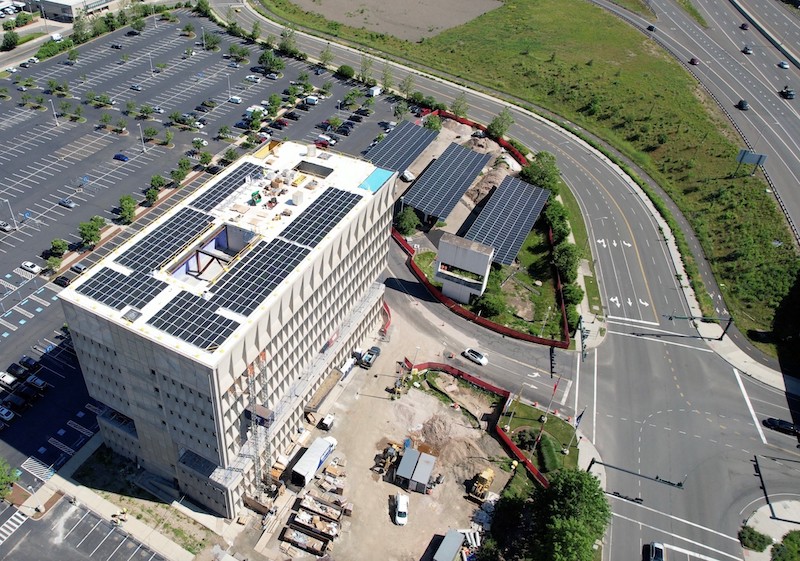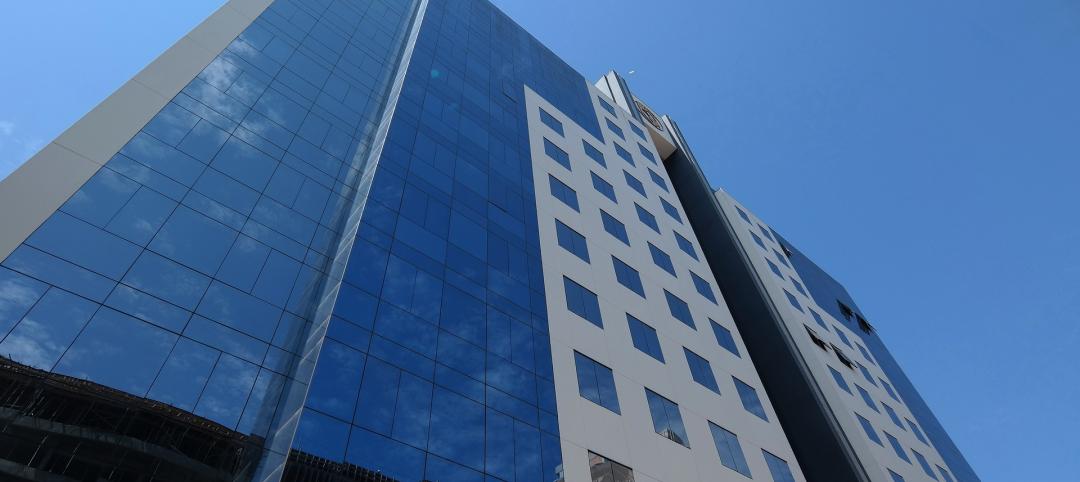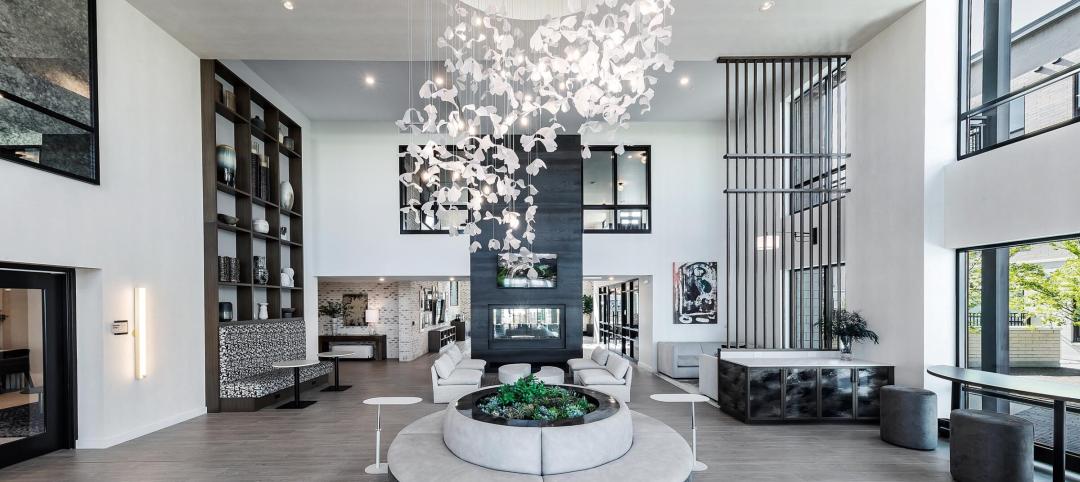Sometime in late Spring of next year, the Hotel Marcel in New Haven, Conn., is scheduled to open. This 110,000-sf, 165-room hotel is being touted by its developer as the first net-zero carbon hotel in the U.S., and its transformation is guided by Passive House and LEED Platinum certification standards.
The former Pirelli Building—named after the famed tire company that bought it as part of Pirelli’s acquisition of Armstrong Tire—was designed in 1967 in the Brutalist style by architect Marcel Breuer. The furniture retailer IKEA, which operates a warehouse right next door, bought the building in 2003, but never used it. In 2018, the city granted permission to repurpose the building—located within New Haven’s Long Wharf district and two miles from Yale University—as a hotel.
The developer Becker + Becker Associates purchased the property—which is listed on the National Historic Register—in January 2020 for a reported $1.2 million. The firm’s President, Bruce Redman Becker, FAIA, AICP, LEED AP, is also the architect on this $50 million restoration project, which will be operated by Chesapeake Hospitality and fall under Hilton’s Tapestry Collection brand. Ten percent of the hotel’s furnishings, including kitchen and vanity countertops, is being supplied by IKEA. The project’s interior designer is Dutch East Design.
DESIGN-BID-BUILD, BUT WITH MORE COLLABORATION
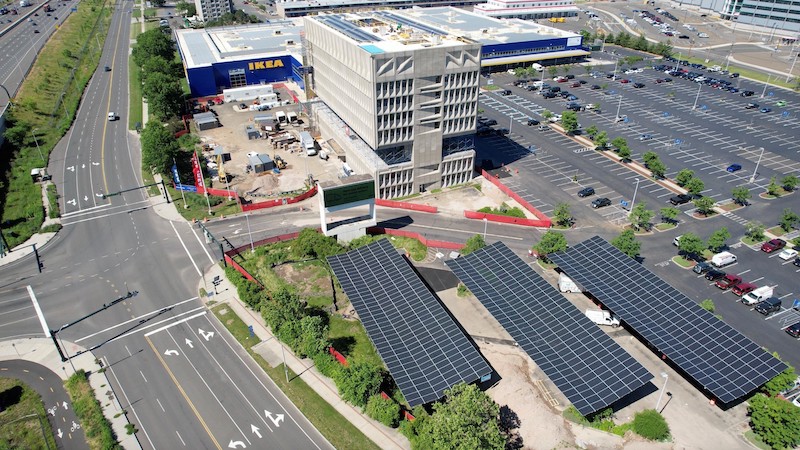
The furniture retailer IKEA owned the Pirelli Building for decades, but never put it to use.
Becker’s interest in sustainable design dates back decades. In 2004, he initiated the “Energy Efficient Housing Technical Correction Act” with New York Congresswoman Carolyn Mahoney. Becker also designed and developed the first two apartment buildings in the U.S. to be powered and heated by a fuel cell.
That latter work drew the attention of the national contractor Consigli, which is serving as Construction Manager for the Hotel Marcel’s adaptive reuse and historic rehabilitation.
“It was a unique challenge to have a relationship with an architect-owner, and to work collaboratively on design details as they came up,” says Aaron Krueger, LEED AP, Project Manager for Consigli, whom BD+C interviewed with Steven Burke, LEED and WELL Faculty, CPHC, Consigli’s Director of Sustainability.
Consigli came on board in 2019, recalls Krueger, when Becker was looking for a preconstruction partner. Consigli worked with the developer on budgeting as well. (Procurement for this project was unusual, says Krueger, in that Becker himself bought the 1,072 solar panels that will power the hotel from their perches on its roof and parking structure; as well as the building’s windows, which were subject to approval along historic criteria.)
Burke says that, prior to its involvement in Hotel Marcel, Consigli had worked on projects powered by renewable energy before: it currently has eight projects being built to achieve net-zero carbon, and six being built to Passive House standards. (Because Hotel Marcel is a retrofit, its Building Team has been following the International Passive House standard.)
SETTING THE BAR FOR HOTEL ENERGY EFFICIENCY
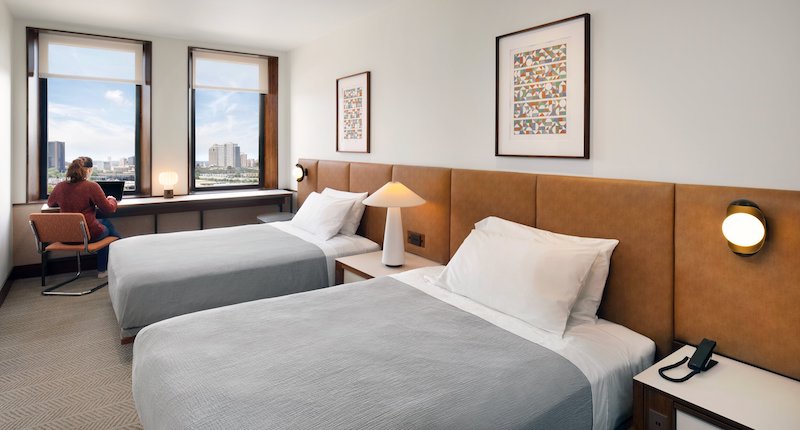
The Hilton Tapestry-branded Hotel Marcel will offer 165 rooms and suites.
The solar arrays will provide 100% of Hotel Marcel’s electricity for lighting, heating, and cooling. The hotel will include among its amenities 12 on-site Tesla superchargers for electric vehicles. Other sustainable features include Mitsubishi variable refrigerated flow air-source heat pumps, an energy recovery system, and recycled and local construction materials. All lighting will be low-voltage power-over-ethernet LED technology. Energy Use Intensity Rating is projected to be 34 kBtu/ft^2, which is 80% less energy than median EUI for hotels in the United States.
All told, Hotel Marcel is aiming to be 60% more energy efficient than code requirements. To hit that target, the Building Team applied spray foam insulation to seal and increase the R-value of the structure’s exterior, which was tricky, says Krueger, because historic preservation requirements limited the extent to which the building’s precast panels could be altered. (Steven Winter Associates is this project’s engineering consultant, and will conduct a whole-building air-barrier test upon completion of this rehabilitation.)
Some of the project’s other challenges included the fact that the building “was filled with hazardous materials, and there was little access to the inside, which really wasn’t abated until last summer,” says Krueger.
Once completed, the building’s penthouse will serve as a 7,000-sf event space for the hotel. Consigli, says Burke, hopes this project becomes an example for future historic restorations that are economically feasible to execute.
Related Stories
Urban Planning | Feb 5, 2024
Lessons learned from 70 years of building cities
As Sasaki looks back on 70 years of practice, we’re also looking to the future of cities. While we can’t predict what will be, we do know the needs of cities are as diverse as their scale, climate, economy, governance, and culture.
Adaptive Reuse | Feb 4, 2024
Corporate modernist buildings increasingly popular fodder for adaptive reuse projects
Beginning in the 1970s adaptive reuse projects transformed 19th and early 20th Century buildings into distinctive retail destinations. Increasingly, developers of adaptive reuse projects are targeting outmoded corporate buildings of the 1950s to 1980s.
Luxury Residential | Jan 30, 2024
Lumen Fox Valley mall-to-apartments conversion completes interiors
Architecture and interior design firm Morgante Wilson Architects (MWA) today released photos of its completed interiors work at Lumen Fox Valley, a 304-unit luxury rental community and mall-to-apartments conversion.
Senior Living Design | Jan 24, 2024
Former Walgreens becomes affordable senior living community
Evergreen Real Estate Group has announced the completion of Bellwood Senior Apartments. The 80-unit senior living community at 542 25th Ave. in Bellwood, Ill., provides independent living options for low-income seniors.
Adaptive Reuse | Jan 23, 2024
Adaptive reuse report shows 55K impact of office-to-residential conversions
The latest RentCafe annual Adaptive Reuse report shows that there are 55,300 office-to-residential units in the pipeline as of 2024—four times as much compared to 2021.
Adaptive Reuse | Jan 18, 2024
Coca-Cola packaging warehouse transformed into mixed-use complex
The 250,000-sf structure is located along a now defunct railroad line that forms the footprint for the city’s multi-phase Beltline pedestrian/bike path that will eventually loop around the city.
Adaptive Reuse | Jan 12, 2024
Office-to-residential conversions put pressure on curbside management and parking
With many office and commercial buildings being converted to residential use, two important issues—curbside management and parking—are sometimes not given their due attention. Cities need to assess how vehicle storage, bike and bus lanes, and drop-off zones in front of buildings may need to change because of office-to-residential conversions.
K-12 Schools | Jan 8, 2024
Video: Learn how DLR Group converted two big-box stores into an early education center
Learn how the North Kansas City (Mo.) School District and DLR Group adapted two big-box stores into a 115,000-sf early education center offering services for children with special needs.
Affordable Housing | Dec 14, 2023
What's next for affordable housing in 2024?
As 2023 draws to a close, GBBN’s Mary Jo Minerich and Amanda Markovic, AIA sat down to talk about the future. What’s next in terms of trends, technology, and construction of affordable housing?
MFPRO+ News | Nov 21, 2023
Underused strip malls offer great potential for conversions to residential use
Replacing moribund strip malls with multifamily housing could make a notable dent in the housing shortage and revitalize under-used properties across the country, according to a report from housing nonprofit Enterprise Community Partners.


